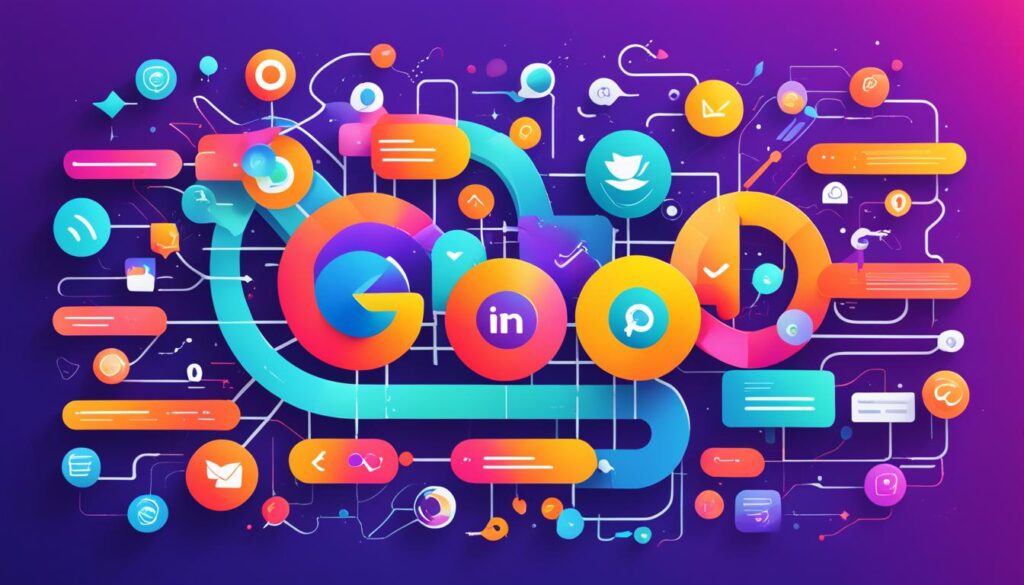Digital marketing offers an array of strategies and channels, from social media to search engines, that can help you expand your reach and achieve your goals.
In this beginner’s guide to digital marketing, we will walk you through the core components of this dynamic field. Whether you are new to digital marketing or looking to enhance your existing knowledge, we’ve got you covered.
Throughout this guide, we will explore important topics such as Search Engine Optimization (SEO), content creation, social media marketing, email marketing, and Pay-Per-Click (PPC) advertising. Understanding these fundamental components will provide you with a solid foundation for your digital marketing journey.
But that’s not all – we will also share insider tips on improving your email marketing efforts, mastering your inbox placement rate, and staying ahead of the digital marketing trends. Additionally, we will provide you with valuable resources to further expand your knowledge and skills.
What is Digital Marketing?
Digital marketing refers to advertising and promotional activities carried out through digital channels. With the increasing popularity of the internet and the widespread use of digital devices, businesses have shifted their focus to digital marketing to reach their target audience effectively.
Common digital marketing channels include:
- Social media platforms like Facebook, Instagram, and Twitter
- Search engines like Google and Bing
- Websites and blogs
- Mobile apps
- Email marketing
- SMS marketing
- Smartphones
Digital marketing offers several advantages over traditional forms of advertising. It provides a wider audience reach, allowing businesses to connect with potential customers worldwide. The ability to target specific demographics and interests ensures that marketing efforts are more effective and cost-efficient. With digital marketing, businesses can track and measure the success of their campaigns, making it easier to optimize strategies and achieve better results.
Understanding and embracing digital marketing is crucial for businesses who want to stay competitive in today’s digital age. By utilizing digital marketing channels effectively, businesses can build brand awareness, generate leads, drive website traffic, and increase sales and revenue.
Core Components of Digital Marketing
In the world of digital marketing, there are several core components that play a crucial role in promoting your business and engaging with your target audience. These components include SEO (Search Engine Optimization), content marketing, social media marketing, email marketing, and PPC (Pay-Per-Click) advertising.
SEO is essential for improving your website’s visibility in search engine results. By optimizing your website’s content, meta tags, and other elements, you can increase your organic rankings and attract more relevant traffic.
Content marketing focuses on creating valuable and relevant content that resonates with your target audience. By providing helpful information, solving problems, and positioning yourself as an industry expert, you can build trust and loyalty among your customers.
Social media marketing allows you to connect with your audience, promote your brand, and drive engagement through various social media platforms like Facebook, Instagram, Twitter, and LinkedIn. By creating compelling content, running targeted ad campaigns, and interacting with your followers, you can build a strong online presence and drive traffic to your website.
Email marketing plays a crucial role in nurturing leads and driving conversions. By creating personalized and relevant email campaigns, you can build relationships with your prospects and customers, provide them with valuable content, and encourage them to take action.
PPC advertising is a paid advertising method that allows you to display your ads on search engines, websites, and social media platforms. By targeting specific keywords and demographics, you can reach your desired audience and drive instant traffic to your website.
These core components of digital marketing work together to create a comprehensive strategy that helps businesses grow and thrive in the digital landscape. By leveraging the power of SEO, content marketing, social media marketing, email marketing, and PPC, you can enhance your online presence, generate leads, and increase conversions.

Why Are These Core Components Important?
Each of these core components plays a unique role in your overall digital marketing strategy. SEO ensures that your website ranks higher in search engine results, making it more visible to potential customers. Content marketing helps you establish thought leadership, build trust, and attract organic traffic to your website. Social media marketing allows you to engage with your target audience, build brand awareness, and drive traffic to your website. Email marketing enables you to nurture leads, provide personalized communication, and drive conversions. PPC advertising allows you to reach a wider audience, drive instant traffic, and generate leads.
By incorporating all these core components into your digital marketing strategy, you can maximize your reach, engage with your audience effectively, and drive meaningful results for your business.
Email Marketing and the Anatomy of a Successful Marketing Email
Email marketing plays a crucial role in any digital marketing strategy, offering a high return on investment (ROI) and the ability to engage with a wide audience. To create successful marketing emails, it is important to understand the key components that make up a compelling message. Let’s explore the anatomy of a successful marketing email:
The Key Components:
1. “From” Field: The sender’s name or brand should be easily recognizable to establish trust and increase open rates.
2. Subject Line: A catchy subject line that grabs attention and entices the recipient to open the email.
3. Preview Text: The short snippet of text that appears below the subject line in the recipient’s inbox, giving a preview of the email’s content.
4. Header: The top section of the email that typically includes the logo, company name, and navigation menu if applicable.
5. Body: The main content of the email, which should be concise, well-written, and include a clear call-to-action (CTA).
6. Visuals: Eye-catching images or videos that support the message and capture the recipient’s attention.
7. Optional Body Elements: Additional elements such as testimonials, customer reviews, or product highlights that reinforce the email’s purpose.
8. Social Media and Other Links: Including links to social media profiles, blog posts, or landing pages can encourage further engagement and website visits.
9. Footer: The bottom section of the email that typically includes contact information, an unsubscribe link, and any relevant legal information.
By including these key components in your marketing emails, you can increase the chances of engagement, conversions, and ultimately, business success. Remember to optimize your email marketing efforts by segmenting your audience, personalizing content, and regularly testing different elements to refine your strategy.
Improving Your Inbox Placement Rate
To ensure the success of your email marketing campaigns, it is crucial to pay attention to your inbox placement rate. This refers to the rate at which your emails are delivered to the recipients’ inboxes rather than being filtered into their spam folders. A high inbox placement rate increases the chances of your emails being seen and engaged with by your target audience. Here are some key factors that influence your inbox placement rate and tips for improving it.
Sender Reputation
Your sender reputation plays a significant role in determining your inbox placement rate. It is a measure of how reputable and trustworthy your email sending practices are. Factors that influence your sender reputation include:
- Low Bounce Rate: Ensure that your email list is up-to-date and regularly cleaned to minimize bounce rates.
- Compelling Subject Lines: Craft subject lines that are engaging and relevant to increase the chances of your emails being opened.
- Different Content Over Time: Avoid sending repetitive or duplicate content to maintain the interest of your subscribers and keep them engaged.
- Sender Authentication: Implement sender authentication technologies like SPF, DKIM, and DMARC to prove the authenticity of your emails.
- Compliance with Email Marketing Laws: Adhere to email marketing laws and regulations, such as including a clear opt-out option and honoring unsubscribe requests promptly.
By focusing on these factors and maintaining a positive sender reputation, you can improve your inbox placement rate and ensure that your emails reach the intended recipients.
Email Marketing Best Practices
In addition to managing your sender reputation, following email marketing best practices can also contribute to a higher inbox placement rate. These practices include:
- Segmenting Your Email List: Group your subscribers based on their preferences and behavior to send targeted and personalized emails.
- Delivering Valuable Content: Provide relevant and valuable content to your subscribers that meets their needs and interests.
- Optimizing for Mobile: Ensure that your emails are mobile-friendly and render correctly on different devices.
- Testing and Analytics: Continuously test and analyze your email campaigns to identify areas for improvement and optimize your strategies accordingly.
By implementing these email marketing best practices, you can not only improve your inbox placement rate but also enhance your overall email marketing performance and engagement with your audience.
Tips for Beginners in Digital Marketing
Are you a beginner in the world of digital marketing? Don’t worry! We’ve got you covered with some helpful tips to kickstart your journey. Let’s dive in and explore these beginner-friendly strategies that will set you up for success.
1. Consistency is Key
Consistency is crucial when it comes to digital marketing. Whether you’re creating content, posting on social media, or sending out emails, maintaining a consistent presence will help you build brand awareness and engage your target audience. Make sure to develop a schedule and stick to it, delivering valuable content regularly.
2. Continuous Learning and Experimentation
To stay ahead in the ever-changing digital landscape, it’s important to embrace continuous learning. Stay updated with the latest digital marketing trends and strategies through blogs, YouTube channels, and online courses. Additionally, don’t be afraid to experiment with different approaches to find what works best for your business.
3. Beginner-Friendly Marketing Channels
As a beginner, it’s essential to focus on marketing channels that are beginner-friendly and yield effective results. Here are some channels you should consider:
- Content Marketing: Creating valuable and relevant content to attract and engage your target audience.
- Email Marketing: Utilizing email campaigns to communicate with your audience and nurture leads.
- Social Media Marketing: Building brand presence and connecting with your audience on social media platforms.
- Online Advertising: Running targeted ads to increase brand visibility and drive traffic to your website.
- SEO: Optimizing your website to rank higher in search engine results and increase organic traffic.
4. Stay Updated with Digital Marketing Trends
Digital marketing is a rapidly evolving field, so it’s crucial to stay updated with the latest trends and techniques. Keep an eye on industry publications, attend webinars, and follow industry leaders to stay ahead of the curve. Understanding and leveraging emerging trends can give you a competitive advantage in the digital marketing landscape.
By following these tips and staying committed to your digital marketing efforts, you’ll be on your way to success in no time. Remember, consistency, continuous learning, and experimenting with different strategies are key elements for beginners in digital marketing. Good luck!
Do’s and Don’ts in Digital Marketing
When it comes to digital marketing, there are certain do’s and don’ts that can make all the difference in the success of your campaigns. By following best practices and avoiding common pitfalls, you can maximize the effectiveness of your digital marketing efforts.
Do:
- Engage with your audience: Interact with your audience through social media, emails, and comments to build meaningful connections and foster loyalty.
- Keep your content relevant and fresh: Regularly update your website, blog, and social media platforms with valuable and up-to-date content.
- Use analytics to guide your decisions: Track your website traffic, social media engagement, and email marketing performance to gain insights and make data-driven decisions.
Don’t:
- Ignore mobile optimization: Ensure that your website and emails are optimized for mobile devices, as a significant portion of internet users access content through their smartphones.
- Overlook the power of SEO: Implement search engine optimization strategies to improve your website’s visibility and organic traffic.
- Neglect your social media presence: Maintain an active and consistent presence on social media platforms relevant to your target audience to increase brand awareness and reach.
By following these do’s and don’ts in digital marketing, you can establish a strong online presence, engage your target audience, and achieve your marketing goals.
Checklist for Effective Digital Marketing
When it comes to digital marketing, having a checklist can help ensure that you cover all the essential elements for success. Whether you’re a beginner or looking to refine your strategy, this checklist will guide you through the key steps to take. Let’s dive in!
1. Define Your Marketing Goals
The first step in any digital marketing campaign is to define your goals. What do you want to achieve? Are you looking to increase brand awareness, drive website traffic, generate leads, or boost sales? Clearly outlining your goals will provide direction for your entire marketing strategy.
2. Identify Your Target Audience
Understanding your target audience is crucial for effective digital marketing. Who are your ideal customers? What are their demographics, interests, and pain points? By creating detailed buyer personas, you can tailor your messaging and campaigns to resonate with your target audience.
3. Choose the Right Marketing Channels
With so many marketing channels available, it’s important to select the ones that align with your goals and target audience. Consider utilizing channels such as social media, search engine advertising, email marketing, content marketing, and influencer partnerships. Each channel has its own strengths and advantages.
4. Create Engaging Content
Content is the heart of digital marketing. Develop high-quality, informative, and engaging content that addresses your target audience’s needs and interests. Use a variety of formats, such as blog posts, videos, infographics, and podcasts, to keep your audience engaged and entertained.
5. Implement SEO Strategies
Search engine optimization (SEO) is essential for gaining visibility and organic traffic. By optimizing your website and content with relevant keywords, meta tags, and backlinks, you can improve your search engine rankings and attract more organic visitors to your site.
6. Monitor and Adjust Based on Analytics
Analytics provide valuable insights into the performance of your digital marketing efforts. Track important metrics, such as website traffic, conversion rates, click-through rates, and social media engagement. Analyzing these data points will help you identify what’s working and what needs improvement, allowing you to make data-driven decisions.
By following this checklist, you’ll be well on your way to executing an effective digital marketing campaign. Remember to continuously evaluate and optimize your strategies to stay ahead in an ever-changing digital landscape.
For more insights on digital marketing strategies, check out this Forbes article.
Conclusion
Digital marketing is an essential component of any business’s marketing strategy in the digital age. With the understanding of the core components of digital marketing, you can effectively leverage digital channels to elevate your brand and achieve substantial results. By implementing best practices and continuously learning and adapting, you can stay ahead of the competition and reach your marketing goals.
To further enhance your knowledge and skills in digital marketing, there are numerous resources available. You can explore blog articles, YouTube channels, and online courses that offer valuable insights and practical tips. These resources can help you stay up to date with the latest trends, techniques, and strategies in digital marketing, empowering you to make informed decisions and optimize your marketing efforts.
Remember, digital marketing is a constantly evolving field, so it’s important to stay curious and continue learning. By embracing digital marketing and utilizing the available resources, you can drive your business forward, engage your audience effectively, and achieve long-term success in the digital landscape.

